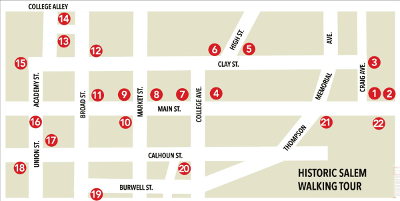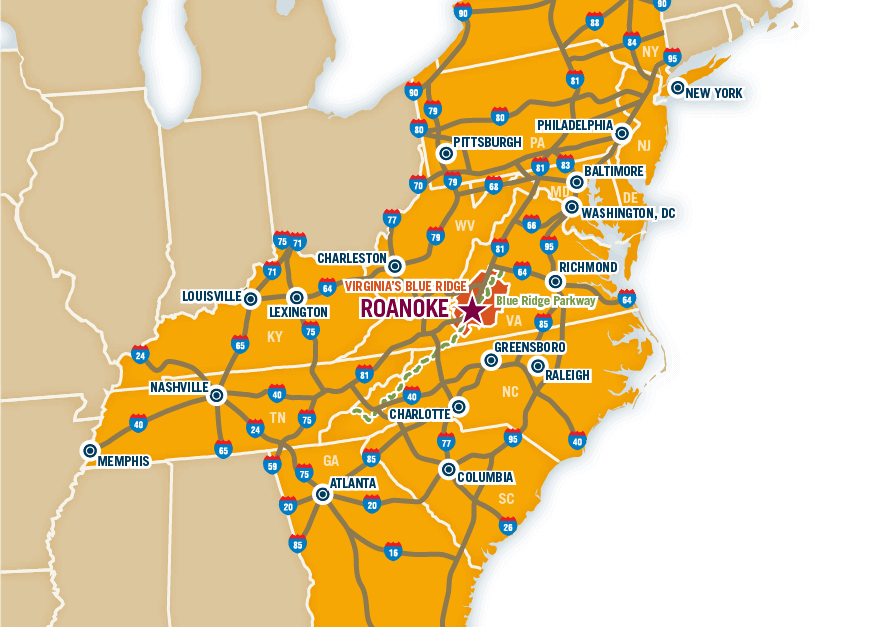Iconic sites that connect you to the region's history and heritage.
-
Things To Do
- Arts & Culture
- Attractions
- Beer, Wine & Spirits
- Blue Ridge Parkway
- Events
- Free Things To Do
- History & Heritage
- Kid Friendly
- Nightlife
-
Outdoor Adventure
- Leave No Trace
- Appalachian Trail
- Biking
- Climbing
- Disc Golf
- Fall Color Spots
- Fishing
- Geocaching
- George Washington & Jefferson National Forests
- Greenways
- Hiking Trails
- Horseback Riding
- Kayaking & Paddling
- Kid Friendly Outdoors
- Motorcycle Touring
- Outdoor Outfitters & Shops
- Scenic Drives
- Water Sports
- Wildlife Viewing & Birding
- Classes & Workshops
- Sample Itinerary
- Sample Itineraries
- Shopping
- Spas
- Sports
- Tours
- VBR Savings Pass
- Hotels/Lodging
- Restaurants
- Region
- Plan
Historic Walking Tour of Salem
The charming community of Salem offers the quaint hospitality, culture, and history that helps make Virginia's Blue Ridge such a unique destination.
This historic walking tour of Salem takes you to some of the iconic places of interest that have helped shape the story of this city over the years.
The sites are numbered in order of tour, though visitors may tour in any sequence.
1. Williams-Brown House Store - 1845
Built in 1845 as a residence, store, and post office by William C. Williams. It was purchased by J.R.C. Brown Jr. in 1852 and was eventually used as a fraternity house in the 1930s, and later as apartments. It's now home to the Salem Historical Society and Salem Museum, which opened in 1992.
2. East Hill Cemetery North - 1871
This two-acre plot of land was a burial ground for the African American community of Roanoke County. Among prominent citizens buried here are the Reverend B.F. Fox, pastor of First Baptist and Shiloh Baptist Church.
3. Site of Longwood Mansion - 1904
This luxurious 18-room residence was built by coal operator Thomas H. Cooper on an 11-acre tract in 1903. It was sold to the City of Salem in 1942 and was used for meetings until a fire destroyed it in 1968. The carriage house survived the fire and is now used as offices by the Chamber of Commerce.
4. Old Courthouse - 1901
As part of Salem's charming Main Street, this structure was built on the site of the first Roanoke County Courthouse. When a new county courthouse was constructed in 1980, the building was acquired by Roanoke College, which now uses it for academic offices and classrooms.
5. Monterey - 1840
Monterey was constructed with bricks that were handmade by enslaved people on the premises and features 12 rooms, a two-story entrance hall, and 12-foot ceilings. It served as a hotel in the early 1900s and is now owned by Roanoke College.
6. Roanoke College - 1847
Originally established in 1842 as the Virginia Institute in Augusta County, the college relocated to Salem five years later. Obtain copies of the Roanoke College walking tour at the Admission Office in Roselawn - 226 High Street.
7. Downtown Salem Historic District
The 25-acre district functions as the core of Salem's downtown district, including the original layout from James Simpson in 1802. Along Main Street, notice the tops of buildings decorated with the original tin work made popular in the late 19th century.
8. Post Office - 1923
Constructed as part of a program that introduced great architecture to many towns, this was Salem's first federally owned post building.
9. Salem Presbyterian Church - 1851
The Presbyterian congregation outgrew its original location on Academy Street and erected this building, using labor from enslaved people, with bricks fired on premises. The structure incorporates numerous architectural designs from popular antebellum handbooks.
10. Old Post Home - 1821
The house first doubled as a residence for Jacob & Sarah Stevens, and provided travelers with a mail drop, exchange for fresh horses, and possibly overnight lodging. It was later used as a private residence and tea house before being purchased by St. Paul's Episcopal Church in 1952, which now uses it for church purposes.
11. Farmers Market
Operating in Salem unofficially for many years, the city market was only formally established in 1992. Open 6 a.m. to dusk, Monday - Saturday, April - December.
12. City Hall - 1912
Constructed in Jeffersonian Revival style, the building served as Salem High School for over 20 years before a fire caused it to close for renovations. Converted into City Hall in 1983.
13. Evans-Webber House - 1882
This lavish example of Second French Empire architecture still boasts its original carved wood cornices, brackets, eaves, and 13-foot ceilings.
14. Rice House - 1867
Built by Salem attorney D.B. Strouse, who renovated the house to include its massive Corinthian columns and porch after seeing a similar one during a trip up north. Walkers may proceed along the alley between the Webber & Rice houses, which was a typical 19th century passageway for the town's people on horseback or foot.
15. Academy Street School - 1890 & 1895
These two Italian style buildings served as a school for the better part of a century until 1977 and are now used as condominiums.
16. Union Street - 1802
In the early 1800s, the Roanoke Navigation Company was headquartered on the corner of Main & Union and sent shipments of cargo on canal down Union Street to the Roanoke River.
17. New Castle - 1820 & 1853
One of Salem's earliest buildings, it originally served as a residence but was later used as living quarters for enslaved people. It was converted into a tobacco factory before becoming North Cross School following World War II. It now houses Olde Salem Furnishings.
18. Queen Anne House - 1888
The home was built as trends moved away from Colonial architecture to a more flowery, creative style. Note the fan-type decorations and many spindles on the porch and cupola over the front bay window.
19. The Water Street Community - 1868
South Broad was once Water Street - Salem's premier African American community. Former enslaved persons bought lots in this area from their former owner's estate in 1868 and established the neighborhood. First Baptist Church remains the pioneer church of Salem's black community.
20. Oakey Duval House - 1880
Built by W.D.E. Duval, this Victorian-era home has served as a private residence and business location in Salem for many years and features seven fireplaces and floors of white oak.
21. Old Manse - 1847
Built by John Day, local blacksmith, this building was later sold to Salem Presbyterian Church, which used it as a home for their ministers until 1939. It has since served as a private residence and B&B.
22. East Hill Cemetery - 1869
After older burial grounds became too crowded, this property was purchased from the estate of Nathaniel Burwell. The body of General Andrew Lewis was moved to East Hill in 1897 from an overgrown family graveyard.
To help navigate while you're in Salem, we also offer a downloadable PDF of this walking tour.
In This Section
Want the latest on Virginia’s Blue Ridge? Securely sign up for our FREE e-newsletter:
Visit Virginia's Blue Ridge 101 Shenandoah Avenue NE Roanoke, VA 24016 (540) 342-6025 (800) 635-5535
Visit Virginia’s Blue Ridge is committed to cultivating an atmosphere that welcomes and celebrates the unique backgrounds, abilities, passions, and perspectives of our vibrant community. As our region’s only destination marketing organization, we have a responsibility to showcase the best the Roanoke Region has to offer, and those assets and strengths come in varied forms. We embrace differences in race, religion, sexual orientation, gender, gender identity or expression, language, visible and invisible disabilities, and all the intersecting identities that make Virginians and visitors alike so unique. We believe our differences make us stronger– and better.









